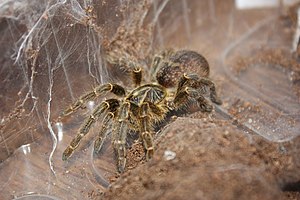Pterinochilus chordatus
| Pterinochilus chordatus | ||||||||||||
|---|---|---|---|---|---|---|---|---|---|---|---|---|

Pterinochilus chordatus |
||||||||||||
| Systematics | ||||||||||||
|
||||||||||||
| Scientific name | ||||||||||||
| Pterinochilus chordatus | ||||||||||||
| ( Gerstäcker , 1873) |
Pterinochilus chordatus is a species of spider in the genus Pterinochilus inthe tarantula family (Theraphosidae). It iswidespreadin Africa and wasdescribedby Carl Eduard Adolph Gerstäcker in 1873.
Appearance and build
The females become 50 millimeters long, the males 30 millimeters. The globe is pear-shaped. There are no keels along the embolus. The carapace is colored beige, gray or black with golden radial lines. Front and abdomen are mainly gray and beige. There is a dark "mask" around the mound. The back of the abdomen is gray or black and has a herringbone pattern. The species has no stinging hairs.
habitat
The seven species of the genus Pterinochilus are common in Central Africa and East Africa. Pterinochilus chordatus lives in Ethiopia , Kenya , Somalia , Sudan , Tanzania and Uganda .
The spider inhabits open landscapes like the savannahs . There she often sits in sand pits. She weaves tubes into which she can withdraw. It occurs at altitudes up to 2100 m.
Way of life
The spiders often settle in open areas, they live on the ground and are not very active during the day. Since the species has no stinging hairs , if disturbed, it straightens itself in a stridulating manner and hits its buttons and front legs.
The spider's bite is not dangerous for humans, but it is very painful.
Systematics
Because of the difference in coloration, color variants of Pterinochilus chordatus have often been described as separate species. By the year 2002, 23 species had accumulated in the genus Pterinochilus . During the Second World War , numerous type specimens by the natural scientist Embrik Strand (1876–1953) were lost in the fire at the State Museum for Natural History in Stuttgart , which made revision difficult. Finally, in the revision of the genus were Pterinochilus by Richard C. Gallon in 2002, the species Pterinochilus wide manni beach, 1906, P. raptor beach, 1906, P. affinis Tullgren, 1910, P. sjostedti Tullgren, 1910, P. Carnivorus beach, 1917, P. brunellii Caporiacco, 1940 and Coelogenium raveni Smith, merged with Pterinochilus chordatus in 1990 . The English name Kilimanjaro mustard baboon (Kilimanjaro mustard tarantula) comes from the location of the type specimen on Kilimanjaro . The German name Kilimanjaro tarantula is used for Pterinochilus meridionalis .
literature
- Andrew M. Smith: Baboon Spiders: Tarantulas of Africa and the Middle East. Dennis Fitzgerald Publishing, 1990 ISBN 0-951-09397-5
- Richard C. Gallon: Revision of the African genera Pterinochilus and Eucratoscelus (Araneae, Theraphisidae, Harpactirinae) with description of two new genera. Bulletin of the British Arachnological Society, 12, 5, pp. 201-231, 2002
Individual evidence
- ↑ Natural History Museum of the Burgergemeinde Bern: World Spider Catalog Version 18.0 - Pterinochilus chordatus . Retrieved July 10, 2017.
- ^ Richard C. Gallon: Revision of the African genera Pterinochilus and Eucratoscelus (Araneae, Theraphisidae, Harpactirinae) with description of two new genera. Bulletin of the British Arachnological Society, 12, 5, pp. 201-231, 2002, p. 201
Web links
Pterinochilus chordatus in the World Spider Catalog
- Genus Pterinochilus on baboonspiders.de
- Pterinochilus - Image of Pterinochilus chordatus and information about the genus
